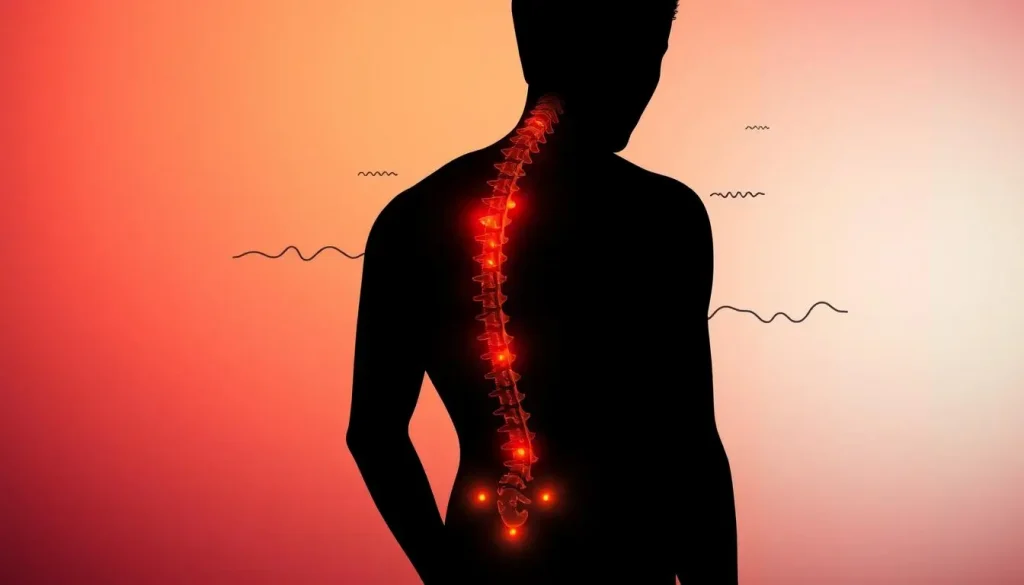Spinal manipulation and chiropractic care are often confused with each other. But they are not the same. Spinal manipulation uses a variety of techniques along the spine to quickly ease pain. On the other hand, chiropractic care focuses on fixing specific spinal problems to improve health over time.
Chiropractic adjustments aim to fix spinal misalignments to help your body heal. They work to restore your spine's function and reduce nerve irritation. In contrast, spinal manipulation is about making joints more flexible to quickly relieve pain.
Knowing the differences between these two is important. It helps you choose the best treatment for your needs.

Key Takeaways
- Spinal manipulation and chiropractic care have distinct goals and approaches
- Chiropractic adjustments focus on correcting spinal misalignments for long-term health benefits
- Spinal manipulation aims to provide immediate pain relief through a broader range of techniques
- Chiropractic care emphasizes restoring proper spinal function and reducing nerve irritability
- Selecting the right treatment depends on individual needs and desired outcomes
Understanding Chiropractic Adjustment
Chiropractic adjustment is a special technique used by licensed chiropractors. It aims to fix spinal misalignments called spinal subluxations. The chiropractor uses a controlled force on specific vertebrae to reduce nerve irritation and improve body function.
What is a Chiropractic Adjustment?
A chiropractic adjustment helps improve spinal motion and range of motion. It aims to restore proper nerve function. The chiropractor may use a quick, short force to target the affected vertebrae. This can lead to an audible release of gas from the joint.
This process can offer pain relief. Some patients might feel brief discomfort if the muscles around the adjustment area spasm.
What Does a Chiropractic Adjustment Involve?
Chiropractors focus on quick and precise adjustments to remove nerve pressure and reduce joint pain. The most common side effect is mild soreness after the first 1-2 treatments, similar to muscle soreness after exercise. Discomfort can be eased with heat, ice, or over-the-counter NSAIDs.
| Chiropractic Adjustment | Spinal Manipulation |
|---|---|
| Targets specific areas of the spine | Addresses the entire spine |
| Offers long-term benefits | Provides short-term pain relief |

Chiropractic adjustments are safe and non-invasive for treating low back and neck pain. The popping sounds during adjustments come from gas bubbles forming and releasing in synovial fluid.
What is Spinal Manipulation?
Spinal manipulation, also known as manual therapy or manipulative therapy, is a wide term. It includes many techniques to apply pressure and movement to the joints. Unlike chiropractic adjustments, it can be used all over the spine and other parts for immediate symptom relief.
Healthcare professionals like osteopaths and physical therapists use different methods. They choose what's best for each patient.
Many Types of Spinal Manipulations
There are many ways to do spinal manipulation. Some common ones are:
- High-velocity, low-amplitude (HVLA) thrust techniques
- Mobilization techniques, such as joint mobilization and soft tissue mobilization
- Instrument-assisted techniques, like the Activator® Instrument
Is Spinal Manipulation Safe?
Spinal manipulation is usually safe when done by a skilled person. But, it can have some risks. Rarely, it might cause stroke or nerve compression.
Treatments with spinal manipulation often take 4-6 weeks to show results.
"Manual-thrust manipulation (MTM) shows statistically significant advantages over mechanical-assisted manipulation (MAM) and usual medical care (UMC) at 4 weeks in reducing disability and pain."
There have been potential associations with cervical thrust manipulation and vertebrobasilar stroke. But, the risks need to be weighed before treatment. Overall, spinal manipulation is safe and effective for pain relief and improved function when done by a qualified healthcare provider.
Techniques Used in Chiropractic Adjustment vs Spinal Manipulation
Chiropractic adjustments and spinal manipulation share some similarities but also have key differences. Chiropractic adjustment techniques focus on specific spinal joints. They aim to fix subluxations and boost nervous system function.
The Diversified Technique is a common method used by about 96% of chiropractors. It's applied to about 70% of their patients. This technique uses high-velocity, low-amplitude (HVLA) thrusts that match the patient's spinal biomechanics.
Spinal manipulation techniques cover a broader range. They can be used on the spine and other parts of the body. Techniques include gentle stretching, firm pressure, and joint mobilization. These methods don't use the HVLA thrust found in chiropractic adjustments.
Some common spinal manipulation techniques include Spinal Mobilization. It works to restore and enhance joint function. The Activator Method Chiropractic Technique uses a small device to treat neck pain, back pain, and headaches.
Chiropractic adjustments target specific spinal joints. Spinal manipulation techniques, on the other hand, can be applied more widely. This offers a broader range of treatment options for practitioners.
"Chiropractic adjustments are known for their specificity, with chiropractors targeting precise spinal joints to address subluxations and improve nervous system function."
Training and Qualifications for Practitioners
To ensure safety and effectiveness, it's key to know the training of healthcare providers. Chiropractors, who focus on musculoskeletal issues, need a lot of education and training. They must complete a 4-year Doctor of Chiropractic (D.C.) degree program.
This program includes over 4,200 hours of study. Topics like anatomy, biomechanics, and spinal adjustment techniques are covered. Also, clinical internships are part of the curriculum. Other healthcare professionals, like osteopathic physicians and physical therapists, may also do spinal manipulation. But their training and expertise can differ a lot.
Chiropractors must pass a three-part exam to show they know their stuff. Physical therapists also have to pass a big exam to practice. This ensures they can provide safe and effective care.
| Chiropractors | Spinal Manipulation Practitioners |
|---|---|
| Attend a 4-year Doctor of Chiropractic (D.C.) programComplete over 4,200 hours of instructionPass the National Board of Chiropractic Examiners examSpecialize in diagnosing and treating musculoskeletal issues | May include osteopathic physicians, physical therapists, and other licensed healthcare providersTraining and expertise can vary widely depending on their field of practiceMust complete the relevant certification exams for their respective professions |
Knowing the qualifications of chiropractor qualifications and spinal manipulation practitioners helps patients make smart choices. It's important to choose licensed and qualified healthcare providers for patient safety. This ensures the best care possible.
If you are interested in know more about Chiropractic, click here in the link below: Chiropractic CPT Codes to Improve Your Insurance Reimbursements
Spinal Manipulation vs Chiropractic: Key Differences
The main difference between chiropractic adjustment and spinal manipulation is their goals and methods. Chiropractic care aims to fix spinal problems for long-term health. It focuses on the body's healing power and finding the cause of pain.
Spinal manipulation, on the other hand, is for quick pain relief. It doesn't always fix the underlying problems. Knowing these differences helps choose the right treatment for you.
Chiropractic Adjustment vs Spinal Manipulation: The Differences
- Chiropractic adjustments are tailored to each person. Chiropractors use hands-on checks and sometimes x-rays to find and fix spinal issues.
- Spinal manipulation includes over 100 methods. Chiropractors use force and twisting on the spine, sometimes with extra treatments.
- Adjustments target specific spine areas, making them better for long-term relief.
- Chiropractic care looks at the whole body. It aims to heal naturally and find the pain's source.
- Spinal manipulation is for short-term pain relief. It gives quick relief but doesn't always fix the problem.
"Manual-thrust manipulation (MTM) provides greater short-term reductions in self-reported disability and pain scores compared to usual medical care (UMC) or mechanical-assisted manipulation (MAM)."
Choosing between chiropractic adjustment and spinal manipulation depends on your health needs. A holistic approach, like chiropractic care, might offer better long-term benefits and overall health.
Benefits of Chiropractic Adjustment and Spinal Manipulation
Chiropractic adjustments and spinal manipulations can help with pain relief and improve how our bodies work. Research shows these methods can offer small but important benefits. They are especially helpful for some muscle and bone problems.
Chiropractic Adjustment Benefits
Chiropractic adjustments aim to fix spinal issues. They are good for pain relief, especially for long-term back pain. Studies show they can also help with sciatica and cervicogenic headaches.
These adjustments can also boost nerve function and joint mobility. They can even lower inflammation in the body. These benefits can make life better and improve overall health.
Manipulation Benefits
Spinal manipulation is also beneficial for some muscle and bone issues. It may help with headaches and neck pain. Some research suggests it can also ease sciatica pain.
But, how well these treatments work can vary. If you don't see improvement after a few weeks, you might want to try something else.
"Chiropractic adjustments can be an effective, low-risk treatment option for certain musculoskeletal conditions, providing modest improvements in pain relief and bodily function."
Conclusion
Spinal manipulation and chiropractic care are not the same, despite being often confused. Chiropractic adjustments focus on fixing spinal misalignments for better health. Spinal manipulation uses various techniques for quick pain relief.
Knowing these differences helps you choose the right treatment for you. It's key to pick what fits your health needs best.
Seeing a licensed chiropractor is a good first step. They can create a treatment plan that fixes the problem and helps your health in the long run. A study showed chiropractic care is better than some other treatments for back pain. But, more research is needed to fully understand the differences.
By learning about chiropractic vs. spinal manipulation, you can make a smart choice. This choice helps you tackle your health issues and reach your wellness goals.
FAQ
What is the difference between spinal manipulation and chiropractic care?
Spinal manipulation and chiropractic care are often confused, but they're different. Spinal manipulation uses various techniques on the spine for quick pain relief. Chiropractic care, however, focuses on fixing specific spinal problems to help your body long-term.
What is a chiropractic adjustment?
A chiropractic adjustment is a special treatment by licensed chiropractors. They use controlled force on specific spine parts to fix misalignments. This helps reduce nerve irritation and boosts body function.
What is spinal manipulation?
Spinal manipulation, or manual therapy, is a wide term. It includes many techniques to ease pain and improve function. Unlike chiropractic adjustments, it's used on the whole spine and body for quick relief.
What are the key differences between chiropractic adjustment and spinal manipulation techniques?
Chiropractic adjustments are precise, focusing on specific spine parts for subluxation correction. They use high-velocity, low-amplitude thrusts. Spinal manipulation, however, uses a variety of techniques on the whole spine and body for immediate relief.
Who can perform chiropractic adjustments and spinal manipulation?
Only licensed chiropractors can do chiropractic adjustments. They have a Doctor of Chiropractic (D.C.) degree after rigorous training. Other healthcare professionals, like osteopathic physicians and physical therapists, can also do spinal manipulation, but their training varies.
What are the benefits of chiropractic adjustments and spinal manipulation?
Chiropractic adjustments can help with chronic back pain, sciatica, and headaches. They offer long-term benefits. Spinal manipulation gives quick relief but might not fix the root cause.
Source Links
- https://impactchiropractic.com/chiropractic-vs-manipulation-key-differences-explained/
- https://www.stpaulnaturalhealth.com/chiropractic-adjustments-vs-spinal-manipulation/
- https://www.ostpt.com/wp-content/uploads/2015/04/Chiropractic-vs-Physical-Therapy.pdf
- https://www.schanuthchiropractic.com/manipulation-vs-adjustment/
- https://www.chiropractorkirkwood.com/therapies/chiropractic-adjustment
- https://www.mayoclinic.org/tests-procedures/chiropractic-adjustment/about/pac-20393513





